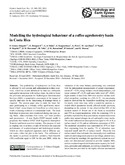| dc.description.abstract | The profitability of hydropower in Costa Rica
is affected by soil erosion and sedimentation in dam reservoirs,
which are in turn influenced by land use, infiltration
and aquifer interactions with surface water. In order to foster
the provision and payment for Hydrological Environmental
Services (HES), a quantitative assessment of the impact of
specific land uses on the functioning of drainage-basins is
required. The present paper aims to study the water balance
partitioning in a volcanic coffee agroforestry microbasin
(1 km2, steep slopes) in Costa Rica, as a first step towards
evaluating sediment or contaminant loads. The main
hydrological processes were monitored during one year, using
flume, eddy-covariance flux tower, soil water profiles
and piezometers. A new Hydro-SVAT lumped model is
proposed, that balances SVAT (Soil Vegetation Atmosphere
Transfer) and basin-reservoir routines. The purpose of such
a coupling was to achieve a trade-off between the expected
performance of ecophysiological and hydrological models,
which are often employed separately and at different spatial
scales, either the plot or the basin. The calibration of
the model to perform streamflow yielded a Nash-Sutcliffe
(NS) coefficient equal to 0.89 for the year 2009, while the validation of the water balance partitioning was consistent
with the independent measurements of actual evapotranspiration
(R2 = 0.79, energy balance closed independently), soil
water content (R2 = 0.35) and water table level (R2 = 0.84).
Eight months of data from 2010 were used to validate modelled
streamflow, resulting in a NS = 0.75. An uncertainty
analysis showed that the streamflow modelling was precise
for nearly every time step, while a sensitivity analysis revealed
which parameters mostly affected model precision,
depending on the season. It was observed that 64% of the
incident rainfall R flowed out of the basin as streamflow
and 25% as evapotranspiration, while the remaining 11% is
probably explained by deep percolation, measurement errors
and/or inter-annual changes in soil and aquifer water stocks.
The model indicated an interception loss equal to 4% of R, a
surface runoff of 4% and an infiltration component of 92%.
The modelled streamflow was constituted by 87% of baseflow
originating from the aquifer, 7% of subsurface nonsaturated
runoff and 6% of surface runoff. Given the low
surface runoff observed under the current physical conditions
(andisol) and management practices (no tillage, planted trees,
bare soil kept by weeding), this agroforestry system on a volcanic
soil demonstrated potential to provide valuable HES,
such as a reduced superficial displacement-capacity for fertilizers,
pesticides and sediments, as well as a streamflow regulation
function provided by the highly efficient mechanisms of aquifer recharge and discharge. The proposed combination
of experimentation and modelling across ecophysiological
and hydrological approaches proved to be useful to account
for the behaviour of a given basin, so that it can be
applied to compare HES provision for different regions or
management alternatives. | es_ES |


